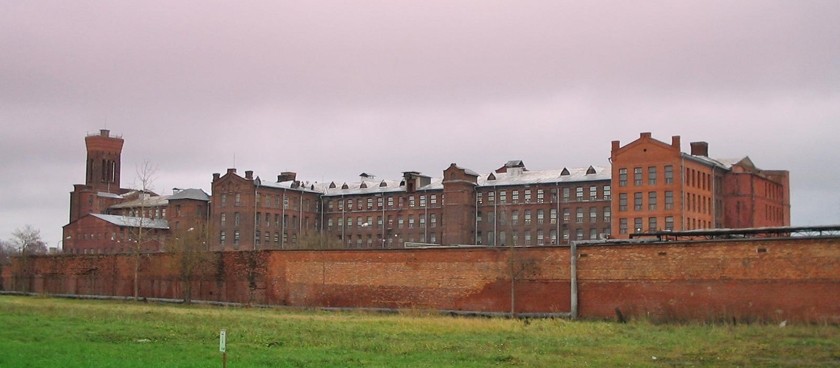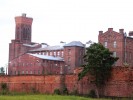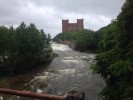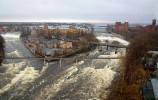- #EE22
- Joala 20, Narva 20103, Estonia
- +3723565670
- info@narvagate.eu
- Prices*:
FREE - * - opening and closing times as well as entrance prices, are subject to alterations without notice. Visitors are advised to check before visiting.
- 59.3606990, 28.1938010 Copy to clipboard Copy
-
#Museums
History
19th century
"The whole place is a bit of England on Russian ground." (Professor Gerhart von Schulze-Gävernitz).
The Krenholm mill was founded in 1857 by the pioneer of the Russian cotton industry, Ludwig Knoop, along with Soldatenkov, and Khludov. After the 1872 cholera epidemic which killed 420 workers, the mill's internal police force was disbanded. But when the administration reintroduced it later in the year, a strike ensued, the first major industrial strike in Estonia, which became a riot, and regular troops were called in to end it. A State Commission investigated the situation, and its report concluded that work conditions had to improve and the internal police ceased to exist. In 1893, it contained 340,000 spindles and 22,000 looms, requiring 6,000 horse power, and employing 7,000 people. Professor Gerhart von Schulze-Gävernitz visited the mills in the 1890s stating that, "The whole place is a bit of England on Russian ground."
The mill is located on an island and along the banks of the Narva River. The Baltic Sea is only about 10 miles away, and in the harbor at the mouth of the river large cotton warehouses were erected where cotton, imported directly from the United States or Liverpool, was stored and brought up the river to the mill as needed. The Narva, just before it runs into the sea, has a fall of about 27 feet which provided a source of power. The machinery was distributed through three separate buildings, of brick and stone construction, two of them being five stories and one four. The last mill, devoted entirely to spinning, was of American construction. The carding and spinning machinery was from the firm of Platt Brothers & Co Ltd, in Oldham, England. Some of the looms were English, but most of them were made by the firm in its foundry and machine works, which were an adjunct of the mill.
Driving power included 11 water turbines with a combined horsepower of 8,550, and supplementary steam engines of 700 horsepower were employed. Seventy per cent of the spindles were used in making yarns for sale principally among weavers in the St. Petersburg and Moscow textile districts. A specialty of the mill was 90s ply yarn, made from Egyptian yarn, for the rubber-tire manufacturers. The range of yarns produced was wide, running from 3s to 90s, and about 330,000 of the spindles were mules. The woven textile consisted mainly of print cloth in various types of construction and sateens, both woven from 34s warp and 38s weft. Practically all the goods were shipped to a factory in Moscow, in which the firm had a large interest.
The managers and assistant managers of the mills were English. The laborers were partly Russian and partly Estonian.[8] The company was active in looking after the welfare of the employees. It provided a hospital, schooling for 1,200 children, a Russian Orthodox Church (built at a cost of $250,000) and a Lutheran church (for the Esthonians). Employees lived at the mill paying only nominal rental.
20th century
The wages paid in 1910 amounted to $1,370,000. In that year, 74,660 bales of cotton were used, from which 34,861,796 pounds of yarn and 159,994 pieces of cloth (average 45 yards each) were used.[9] Before the war, this mill employed over 10,000 people and manufactured yearly over 70,000,000 yards of semi-finished cotton cloth, which was sent to Russia for bleaching and dyeing, and then utilized in Russia. The Estonian cotton industry experienced a crisis after World War I which resulted in the practical closure of the mill, which at the time, was the largest mill in the former Russian Empire. The closure occurred as there was no market for this cloth due to post-war conditions in Soviet Russia.
By 1944, the company was in ruins, and came under the ownership of the Soviet Union, which turned it into a large industrial enterprise, driven by policy rather than profits. In the early 1970s, the company reportedly owned 32,000 acres of land and employed 12,000 people. After 1986, the company did not have to rely on approvals from the textile ministry in Moscow, and was able to export its goods using independent judgement. The company was privatised in 1994 after Estonia regained independence. Its main shareholder became the Swedish company, Borås Wäfveri AB. Renamed Krenholm Group, the realignment included several production units, Krenholm Finishing, Krenholm Sewing, Krenholm Spinning, Krenholm Terry Clothes, Krenholm Weaving; a service unit, Krenholm Service; and sales subsidiaries, Krenholm Textile, Krenholm Scandinavia AB, and Krenholm Germany GmbH.
21st century
In recent years, the company lost money, and was under restructuring; many employees lost their jobs. In 2003, the company was forced to fire 170 workers after the closure of its spinning facility. In early 2004, the company had 4,600 workers, of which a further 400 were made redundant in April 2004. There was speculation in 2008 and 2009 that the company would go bankrupt, and it eventually did in November 2010. It was purchased by the Swedish company Prod i Ronneby AB whose affiliate company in Narva, Eurotekstiil, would continue some of the operations; Ithere were about 500 people employed. By 2012, the company chairman stated that it would be "absolutely impossible" to restore the previous scale of operations.
Know Before You Go
You can only enter with a guide on Sundays at 12:00, at the old gate (opposite Joala street 30/32) guides wait for tourists to come. Tickets are sold on the spot and cost 13 euros per person, cash only. There are guides that do tours in Russian and Estonian. English tours need to be pre-booked via Narva Castle Museum.
Be sure to switch your mobile data not to get a roaming bill! This place literally is on the border (pedestrian border crossing right next to the island), so Russian mobile charges would apply.



